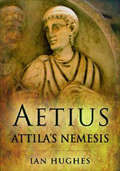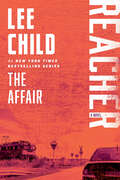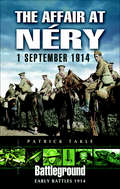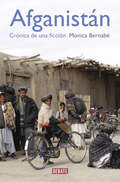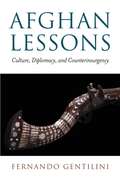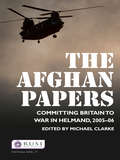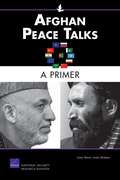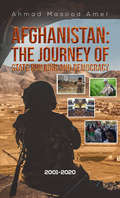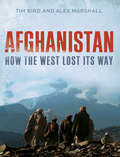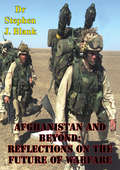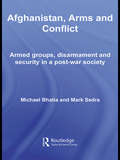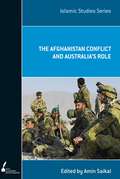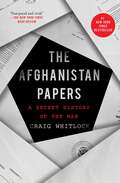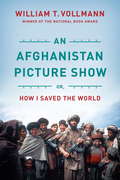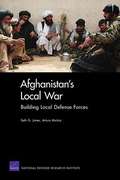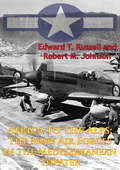- Table View
- List View
Aetius: Attila's Nemesis
by Ian HughesIn AD 453 Attila, with a huge force composed of Huns, allies and vassals drawn from his already-vast empire, was rampaging westward across Gaul (essentially modern France), then still nominally part of the Western Roman Empire. Laying siege to Orleans, he was only a few days march from extending his empire from the Eurasian steppe to the Atlantic. He was brought to battle on the Cataluanian Plain and defeated by a coalition hastily assembled and led by Aetius. Who was this man that saved Western Europe from the Hunnic yoke? While Attila is a household name, his nemesis remains relatively obscure.
The Affair: A Jack Reacher Novel (Jack Reacher #16)
by Lee Child#1 NEW YORK TIMES BESTSELLER • Don&’t miss the hit streaming series Reacher! &“A veritable tour de force . . . brilliantly executed and deliciously plotted.&”—The Washington TimesEverything starts somewhere. For elite military cop Jack Reacher, that somewhere was Carter Crossing, Mississippi, way back in 1997. Reacher is ordered undercover to investigate the murder of a young woman. Evidence points to a U.S. soldier with powerful friends. Once in Carter Crossing, Reacher meets local sheriff Elizabeth Deveraux, who has a thirst for justice and an appetite for secrets. Uncertain they can trust each other, they reluctantly join forces. Reacher works to uncover the truth, while others try to bury it forever. The conspiracy threatens to shatter his faith in his mission— and turn him into a man to be feared.
The Affair at Honey Hill
by Berry FlemingWhile Berry Fleming's interest in history has produced two books of non-fiction, one of which dealt with the Civil War (Autobiography of a City in Arms), The Affair at Honey Hill marks the first time he has used the Civil War as a setting for any of his novels. The story is presented through the eyes of Edwin Daws, a 56 year old Confederate soldier, from his present day (winter, 1864) awareness, as well as his memories, both recent and past. Assigned with his militia company, The Silver Grays, to repel an assault on the railroad leading into Savannah near Honey Hill Plantation, he recalls the month he spent there 18 years earlier, working as a scribe for the Reverend Trezevant Ferebee, and of his growing love for the Reverend's enigmatic daughter-in-law, Julia. What is to become of them now with Sherman's forces moving fast to attack the city? Where is Julia? Can he find her in all this desperate confusion and extricate her? The Affair at Honey Hill is a tight and graphic narrative of human beings--civilians and soldiers--caught in the stress of war and defeat, ripe with the sounds and smells and textures of loves and battles, of opportunities lost and gained, and of hard moral decisions.
The Affair at Néry: 1 September 1914 (Battleground Early Battles 1914)
by Patrick TakleEarly on 1 September 1914, the Germans surprised 1st Cavalry Brigade harboring in the little town of Nry. Their initial bombardment caused chaos and destruction and the British took time to organize themselves. The actions of two batteries of the Royal Horse Artillery were eventually so successful that even today there is a battery known as Nry Battery RHA. The Queens Bays a cavalry regiment, charged in classic style and the Germans, who mistakenly thought they were out numbered, withdrew with heavy casualties.Of the three VCs, two were posthumous.While a small engagement by later Great War standards, Nry is a classic case study of an artillery duel and cavalry action.
An Affair of Spies: A Novel
by Ronald H. BalsonFrom the winner of the National Jewish Book Award—Ronald H. Balson's An Affair of Spies tells of a spy mission to rescue a defector from Germany and prevent the Nazis from creating an atomic bomb.Nathan Silverman grew up in Berlin in the 1920s, the son of a homemaker and a theoretical physicist. His idyllic childhood was soon marred by increasing levels of bigotry against his family and the rest of the Jewish community, and after his uncle is arrested on Kristallnacht, he leaves Germany for New York City with only his mother’s wedding ring to sell for survival.While attending an evening course at Columbia in 1942, Nathan notices a recruitment poster on a university wall and decides to enlist in the military and help fight the Nazi regime. To his surprise, he is quickly selected for a special assignment; he is trained as a spy, and ordered to report to the Manhattan Project. There he learns that the Allies are racing to develop a nuclear weapon before the Nazis, and a German theoretical physicist is hoping to defect. The physicist was a friend of his father's, and Nathan's mission is to return to Berlin via France and smuggle him out of Europe.Nathan will be accompanied by Dr. Allison Fisher, a brilliant young scientist who can speak French; he travels to her lab at the University of Chicago for a crash course in nuclear physics, then they embark on their adventure. Nathan and Allison soon develop feelings for one another, but as their relationship deepens they move ever closer to their dangerous goal. Will they be able to escape Europe with the defector and start a new life together, or will they fail their mission and become two more casualties of war?An Affair of Spies is an action-packed tale of heroism and love in the face of unspeakable evil. Author Ronald H. Balson has applied his unmatched talent for evocative and painstakingly authentic storytelling to the high-stakes world of espionage and created his most thrilling novel yet.
The Affair of the Brains
by Anthony GilmoreHawk Carse himself goes to keep Judd the Kite's rendezvous with the sinister genius Ku Sui.
Afganistán
by Mónica BernabéEn agosto del año 2000, Mònica Bernabé viajó por primera vez a Afganistán con la intención de conocer de primera mano el régimen talibán. Llegó invitada por una mujer afgana a quien había entrevistado en Barcelona tiempo atrás, la presidenta de una asociación clandestina creada para alfabetizar a mujeres y niñas en un momento en el que la educación era algo prohibido para ellas. El libro narra en orden cronológico los principales acontecimientos ocurridos en este país lleno de contradicciones y tan desconocido para nosotros a lo largo de más de una década: la caída del régimen talibán, las consecuencias del 11S o la presencia de las tropas españolas en Afganistán. Mònica Bernabé nos cuenta la verdadera historia de un país que solo se conoce por los tópicos informativos.
Afghan Lessons
by Fernando GentiliniFernando Gentilini served nearly two years as the civilian representative of NATO in Afghanistan, running a counterinsurgency campaign in the wartorn nation. Afghan Lessons is the fascinating story of his mission, a firsthand view of Afghanistan through a kaleidoscope. He explores Afghan history, literature, tradition, and culture to understand some of the most basic questions of Western involvement: What is the purpose? What does an international presence mean, and how can it help?Highlights from Afghan Lessons"This is a book about different worlds, different realities. The reality of everyday life in an unreal world. People that need to be looked after, jobs that need to be done, a country that needs to be restored, all from within the necessary confines of an armed camp. And this in the middle of another reality, which we do not understand, full of things forgotten under decades of war. The keys to this reality lie in the past, perhaps lost." -from the Foreword by Robert Cooper"To tempt me to explore their country, the Afghans kept repeating that there were three different Afghanistans: 'The first is the one you Westerners imagine; another coincides with the city of Kabul; the third is the country of remote provinces, far away from the cities, and of the three, this is the only real Afghanistan.'""'There can be no development without security and no security without development.' ... Everyone said it over and over again, both the civilians and the military, but depending on whether it was said by the former or the latter, the emphasis was placed on the first or second part of the slogan. In all honesty this seemingly obvious concept concealed two contrasting ways of seeing things."
The Afghan Papers: Committing Britain to War in Helmand, 2005–06 (Whitehall Papers #Vol. 77)
by Michael ClarkeIn 2006, British forces entered the Helmand Province of Afghanistan in what would become one of the defining military campaigns of the decade. At great cost in blood and treasure, the UK waged a protracted counter-insurgency against a resurgent Taliban. But how was the decision taken to commit Britain to such a difficult and drawn out campaign? The Afghan Papers is the result of private interviews with and frank contributions by some of the most important actors in the fateful decision. Former generals, politicians and civil servants contribute to an original RUSI analysis that provides a startling insight into the decision to commit the UK to a war – a decision wracked by conflict, incoherence and confusion.
Afghan Peace Talks
by James Shinn James DobbinsThe objective of a negotiated peace in Afghanistan has been firmly embraced by most of the potential parties to a treaty. However, arriving at an agreement about the sequencing, timing, and prioritization of peace terms is likely to be difficult, given the divergence in the parties' interests and objectives. The U.S. objective in these negotiations should be a stable and peaceful Afghanistan that neither hosts nor collaborates with terrorists.
Afghanistan: The Journey of State Building and Democracy 2001-2020
by Ahmad Masood AmerThe Journey of State Building and Democracy in Afghanistan is a review of the state-building and democratic-governance process in the country which started after the US-led international intervention which toppled the Taliban regime and established a new government. This period marks a new era in the contemporary history of the country which it has never experienced before. From 1993-2001, the country was left deep in crisis and the world forgot Afghanistan after the collapse of the Soviet-backed regime in 1992 and creation of the Taliban. The nation experienced one of their darkest periods in history and the country was turned into a safe haven for international terrorism. After the 9/11, which shook the world, the country came back to international spot light. With support by the international community, reconstruction and development started and major investments were made in building state institutions and establishing democracy and freedom. With the global politics and foreign policy interest of the international allies constantly shifting, the country is again in a critical juncture. Albeit with relative success, there is fear that the country would backslide if international involvement is withdrawn. This book reviews the progress in institution building and the experience of democratic system of governance over the past two decades. It highlights critical points and lessons for the policy makers and the political elites to remedy the current situation and bring changes in as the country continues its journey.
Afghanistan: How the West Lost its Way
by Tim Bird Alex MarshallIn October 2001, NATO forces invaded Afghanistan. Their initial aim, to topple the Taliban regime and replace it with a more democratic government aligned to Western interests, was swiftly achieved. However, stabilizing the country in the ensuing years has proven much more difficult. Despite billions of dollars in aid and military expenditure, Afghanistan remains a nation riddled with warlords, the world's major heroin producer, and the site of a seemingly endless conflict between Islamist militants and NATO forces. In this timely and important book, Tim Bird and Alex Marshall offer a panoramic view of international involvement in Afghanistan from 2001 to 2011. Tackling the subject matter as a whole, Bird and Marshall weave together analysis of military strategy, regional context, aid policy, the Afghan government, and the many disagreements between and within the Western powers involved in the intervention. Given the complicating factors of the heroin trade, unwelcoming terrain, and precarious relations with Pakistan, the authors acknowledge the ways in which Afghanistan has presented unique challenges for its foreign invaders. Ultimately, however, they argue that the international community has failed in its self-imposed effort to solve Afghanistan's problems and that there are broader lessons to be learned from their struggle, particularly in terms of counterinsurgency and the ever-complicated work of "nation-building. " The overarching feature of the intervention, they argue, has been an absence of strategic clarity and coherence.
Afghanistan: The Soviet Union's Last War
by Mark GaleottiThe Soviet Union's last war was played out against the backdrop of dramatic change within the USSR. This is the first book to study the impact of the war on Russian politics and society. Based on extensive use of Soviet official and unofficial sources, as well as work with Afghan veterans, it illustrates the way the war fed into a wide range of other processes, from the rise of grassroots political activism to the retreat from globalism in foreign policy.
Afghanistan And Beyond: Reflections On The Future Of Warfare
by Dr Stephen J. BlankMany military analysts believe or fear that the wars of the 1990s will be akin to the wars in the former Yugoslavia: small-scale but long-lasting and recurrent ethnic wars that also elude easy international resolution. There are consequently well-founded concerns about prospects for deployment of U.S. forces there in a unilateral or U.N. capacity. Some of the lessons of this kind of war were already apparent in the wars of the 1980s. They were known then as low-intensity conflicts and now as operations other than, or short of, war.This report focuses mainly on lessons from one of the most crucial of these wars, i.e., in Afghanistan as a result of the Soviet invasion in 1979, and attempts to draw lessons that are relevant for current wars, like those in Yugoslavia or the ex-Soviet Union. The purpose is to stimulate analysis and reflection on the strategic and operational, if not also tactical nature of these wars by both analysts and policymakers so that all interested groups can more easily come to terms with a form of warfare that promises to be both deeply destructive and deeply rooted in longstanding political and social antagonisms that cannot be easily or quickly resolved.Naturally some of the lessons drawn from Afghanistan and other wars may either only apply to Russian and Soviet forces or conversely may apply to war in general. But our primary intention is to make a contribution to the study of future wars particularly of the ethnic and small-scale type that promise to continue in many parts of the globe lest we devise better ways for averting and then resolving them.
Afghanistan, Arms and Conflict: Armed Groups, Disarmament and Security in a Post-War Society (Contemporary Security Studies)
by Michael Vinay Bhatia Mark SedraThis is the first book to provide a comprehensive assessment of small arms and security-related issues in post-9/11 Afghanistan. It includes case studies which reveal the findings of in-depth field research on hitherto neglected regions of the country, and provides a distinctive balance of thematic analysis, conceptual models and empirical research. Exploring various facets of armed violence and measures to tackle it, the volume provides significant insight into broader issues such as the efficacy of international assistance, the ‘shadow’ economy, warlordism, and the Taliban-led insurgency. In an effort to deconstruct and demystify Afghanistan’s alleged ‘gun culture’, it also explores some of the prevailing obstacles and opportunities facing the country in its transition period. In so doing, the book offers valuable lessons to the state-builders of Afghanistan as well as those of other countries and regions struggling to emerge from periods of transition. This book will be of much interest to all students of Afghanistan, small arms, insurgency, Asian Studies, and conflict studies in general.
Afghanistan Cave Complexes 1979-2004
by Ian Palmer Mir BahmanyarFollowing the Soviet invasion in 1979, the Mujahideen defenders of Afghanistan developed and reinforced many natural cave systems to use as supply bases and defensive positions. The Taliban and Al Qaeda further strengthened these positions in the 1990s. Following the events of September 11, 2001, these cave systems have once more come to prominence and sites such as Tora Bora and Zhawar Kili have featured in news headlines around the world. This title provides an analysis of these caves and underground systems, and discusses the U.S.-led Coalition's tactical approach to dislodging the enemy from these fortified positions.
Afghanistan Conflict and Australia's Role (Islamic Studies Series)
by Amin SaikalA decade after the US-led invasion of Afghanistan in October 2001, the country continues to face a growing insurgency and crises of governance. The Afghanistan Conflict and Australia's Role tackles a number of critical dimensions-politics, society, military, and reconstruction-of this conflict from a range of perspectives.This book unpacks the nature and complexity of the conflict at national and international levels. It makes a critical assessment of the performance of President Hamid Karzai and his government, and the efforts made by the international community, the US and its NATO and non-NATO allies in particular, to stabilise, rebuild and secure Afghanistan as a viable state. In addition, it examines critically the role played by Australia in the conflict.The conclusions are far-reaching, with relevance to anyone interested in the interconnectedness of many contemporary issues-governance, democratisation, development, the role of the media, and counterinsurgency. Islamic Studies Series - Volume 8
Afghanistan, Pakistan and Strategic Change: Adjusting Western regional policy (Asian Security Studies)
by Iv Joachim Krause Charles King MalloryThe region encompassing Afghanistan and Pakistan (Af/Pak region) is undergoing a fundamental strategic change. This book analyses the nature of this strategic change, in ordre to seek possible future scenarios and to examine policy options. It also undertakes a critical review of the basic elements of the Western strategic approach towards dealing with regional conflicts in all parts of the world, with special emphasis on the Af/Pak region.Dealing with the political developments i one of the most volatile regions in the world – Afghanistan and Pakistan – the volume focuses on Western strategic concerns. The withdrawal of ISAF by 2014 will change the overall political setting and the work addresses the challenges that will result for Western policymakers thereafter. It examines the cases of Afghanistan and Pakistan separately, and also looks at the broader region and tries to identify different outcomes. This book will be of much interest to students of Central and South Asian politics, strategic studies, foreign policy and security studies generally.
The Afghanistan Papers: A Secret History of the War
by Craig Whitlock The Washington PostA Washington Post Best Book of 2021 The #1 New York Times bestselling investigative story of how three successive presidents and their military commanders deceived the public year after year about America&’s longest war, foreshadowing the Taliban&’s recapture of Afghanistan, by Washington Post reporter and three-time Pulitzer Prize finalist Craig Whitlock.Unlike the wars in Vietnam and Iraq, the US invasion of Afghanistan in 2001 had near-unanimous public support. At first, the goals were straightforward and clear: defeat al-Qaeda and prevent a repeat of 9/11. Yet soon after the United States and its allies removed the Taliban from power, the mission veered off course and US officials lost sight of their original objectives. Distracted by the war in Iraq, the US military become mired in an unwinnable guerrilla conflict in a country it did not understand. But no president wanted to admit failure, especially in a war that began as a just cause. Instead, the Bush, Obama, and Trump administrations sent more and more troops to Afghanistan and repeatedly said they were making progress, even though they knew there was no realistic prospect for an outright victory. Just as the Pentagon Papers changed the public&’s understanding of Vietnam, The Afghanistan Papers contains &“fast-paced and vivid&” (The New York Times Book Review) revelation after revelation from people who played a direct role in the war from leaders in the White House and the Pentagon to soldiers and aid workers on the front lines. In unvarnished language, they admit that the US government&’s strategies were a mess, that the nation-building project was a colossal failure, and that drugs and corruption gained a stranglehold over their allies in the Afghan government. All told, the account is based on interviews with more than 1,000 people who knew that the US government was presenting a distorted, and sometimes entirely fabricated, version of the facts on the ground. Documents unearthed by The Washington Post reveal that President Bush didn&’t know the name of his Afghanistan war commander—and didn&’t want to meet with him. Secretary of Defense Donald Rumsfeld admitted that he had &“no visibility into who the bad guys are.&” His successor, Robert Gates, said: &“We didn&’t know jack shit about al-Qaeda.&” The Afghanistan Papers is a &“searing indictment of the deceit, blunders, and hubris of senior military and civilian officials&” (Tom Bowman, NRP Pentagon Correspondent) that will supercharge a long-overdue reckoning over what went wrong and forever change the way the conflict is remembered.
An Afghanistan Picture Show
by William T. VollmannNever before available in paperback and all but invisible for twenty years, a personal account of the origins of America's longest war.In 1982, the young William Vollmann worked odd jobs, including as a secretary at an insurance company, until he'd saved up enough money to go to Afghanistan, where he wanted to join the mujahedeen to fight the Soviets. The resulting book wasn't published until 1992, and Library Journal wrote: "The wrong book written at the wrong time. . . . With the situation in Afghanistan rapidly heading toward resolution . . . libraries may safely skip this."Thirty years later--and with the United States still mired in the longest war of its history--it's time for a reassessment of Vollmann's heartfelt tale of idealism and its terrifying betrayals.An alloy of documentary and autobiographical elements characteristic of Vollmann's later nonfiction, An Afghanistan Picture Show is not a work of conventional reportage; instead, it's an account of a subtle and stubborn consciousness grappling with the limits of will and idealism imposed by violence and chaos.
Afghanistan's Local War: Building Local Defense Forces
by Arturo Munoz Seth G. JonesIn Afghanistan, local communities have played a critical role in security, especially in rural areas. Afghan national security forces are important to the top-down strategy, but the Afghan government and NATO forces also need to leverage local communities to gain a complementary bottom-up strategy. This analysis discusses the viability of establishing local security forces in Afghanistan and addresses concerns about the wisdom of such policies.
Africa: Volume 2 (Adelphi Papers Reissue Hardback)
by variousComplete set Since 1961 the Adelphi Papers have provided some of the most informed accounts of international and strategic relations. Produced by the world renowned International Institute of Strategic Studies, each paper provides a short account of a subject of topical interest by a leading military figure, policy maker or academic. The project reprints the first forty years of papers, arranged into thematic sets. The collection as a whole provides a rich and insightful account of international affairs during a period which spans the second half of the Cold War, the fall of the communist bloc and the emergence of a new regime with the United States as the sole superpower. There is a wealth of global coverage: Four volumes on east and southeast Asia as well as individual volumes on China, Japan and Korea Particular attention is given to the Middle East, with volumes addressing internal sources of instability; geo-politics and the role of the superpowers; the Israel-Palestine conflict; and the Iran-Iraq War and the first Gulf War. There is also a volume on oil and insecurity There are also two volumes on Africa, the site of most of the world’s wars during the period The IISS has obviously made a particular contribution to the understanding of military strategy, and this is reflected with material on topics such as urban and guerrilla warfare, nuclear deterrence and the role of information in modern warfare. Volumes on military strategy are complemented by approaches from other disciplines, such as defence economics. Key selling points: Early papers were only distributed by the IISS and will have achieved limited penetration of the academic market A host of major authors on a range of different subjects (eg Gerald Segal on China, Michael Leifer on Southeast Asia, Sir Lawrence Freidman on the revolution in military affairs, Raymond Vernon on multinationals and defence economics) Individual volumes will have a strong appeal to different markets (eg the volume on defence economics for economists, various volumes for Asian Studies etc)
Africa: Volume 1 (Adelphi Papers Reissue Hardback)
by variousComplete set Since 1961 the Adelphi Papers have provided some of the most informed accounts of international and strategic relations. Produced by the world renowned International Institute of Strategic Studies, each paper provides a short account of a subject of topical interest by a leading military figure, policy maker or academic. The project reprints the first forty years of papers, arranged into thematic sets. The collection as a whole provides a rich and insightful account of international affairs during a period which spans the second half of the Cold War, the fall of the communist bloc and the emergence of a new regime with the United States as the sole superpower. There is a wealth of global coverage: Four volumes on east and southeast Asia as well as individual volumes on China, Japan and Korea Particular attention is given to the Middle East, with volumes addressing internal sources of instability; geo-politics and the role of the superpowers; the Israel-Palestine conflict; and the Iran-Iraq War and the first Gulf War. There is also a volume on oil and insecurity There are also two volumes on Africa, the site of most of the world’s wars during the period. The IISS has obviously made a particular contribution to the understanding of military strategy, and this is reflected with material on topics such as urban and guerrilla warfare, nuclear deterrence and the role of information in modern warfare. Volumes on military strategy are complemented by approaches from other disciplines, such as defence economics. Key selling points: Early papers were only distributed by the IISS and will have achieved limited penetration of the academic market A host of major authors on a range of different subjects (eg Gerald Segal on China, Michael Leifer on Southeast Asia, Sir Lawrence Freidman on the revolution in military affairs, Raymond Vernon on multinationals and defence economics) Individual volumes will have a strong appeal to different markets (eg the volume on defence economics for economists, various volumes for Asian Studies etc)
Africa and World War II
by Byfield, Judith A. and Brown, Carolyn A. and Parsons, Timothy and Sikainga, Ahmad Alawad Judith A. Byfield Carolyn A. Brown Timothy Parsons Ahmad Alawad SikaingaThis volume considers the military, economic, and political significance of Africa during World War II. The essays feature new research and innovative approaches to the historiography of Africa and bring to the fore issues of race, gender, and labor during the war, topics that have not yet received much critical attention. It explores the experiences of male and female combatants, peasant producers, women traders, missionaries, and sex workers. The first section offers three introductory essays that give a continent-wide overview of how Africa sustained the Allied effort through labor and resources. The six sections that follow offer individual case studies from different parts of the continent. Contributors offer a macro and micro view of the multiple levels on which Africa's contributions shaped the war as well as the ways in which the war affected individuals and communities and transformed Africa's political, economic, and social landscape.
Africa To The Alps: The Army Air Forces In The Mediterranean Theater [Illustrated Edition]
by Edward T. RussellIncludes over 14 photos and mapsBy the time the U.S. declared war on Germany and Italy on December 11, 1941, most of Europe had fallen under the domination of Adolf Hitler, dictator of Germany's Third Reich. In the west, only Great Britain, her armies expelled from the European continent, remained defiant; in the east, Hitler faced an implacable foe-the Soviet Union. While the Soviets tried to stave off a relentless German attack that had reached Moscow, Britain and her Commonwealth allies fought a series of crucial battles with Axis forces in North Africa.Initially, America's entry into the war changed nothing. The U.S. continued to supply the Allies with the tools of war, as it had since the passage of the Lend-Lease Act in March 1941. U.S. military forces, however, had to be expanded, trained, equipped, and deployed, all of which would take time.With the U.S. in the war, the Allies faced the question of where American forces could best be used. President Franklin D. Roosevelt and British Prime Minister Winston S. Churchill had already agreed that defeating first Germany and then Japan would be their policy, but that decision raised further questions.Roosevelt wanted U.S. troops in combat against German troops as soon as possible. Josef Stalin, the Soviet leader, demanded a second front in northern Europe to relieve pressure on his armed forces. Churchill, fearing German power in France, hoped for a strike at the Mediterranean periphery of Hitler's conquests-what he called the "soft underbelly" of Europe.Churchill proposed an invasion of northwest Africa for late 1942 and Roosevelt agreed...Africa to the Alps describes the participation of the Army Air Forces in the war in the Mediterranean theater of operations, as it developed a practical air-ground doctrine, established an effective interdiction strategy, and gained valuable experience in airborne operations and close air support of ground troops.
